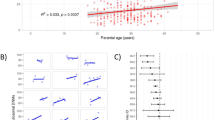Abstract
Nonsyndromic mental retardation (NSMR) is the diagnosis of exclusion in mentally retarded individuals without additional abnormalities. We have recently identified a protein-truncating mutation, G408fsX437, in the gene CC2D1A on chromosome 19p13.12 in nine consanguineous Israeli Arab families with severe autosomal recessive NSMR, and have developed a comprehensive prevention program among the at-risk population in the village. The subjects tested were healthy women who were invited to undergo the genetic screening test as a part of their routine pregnancy monitoring. One hundred and seventeen subjects reported a family history positive for mental retardation. We tested 524 pregnant or preconceptional women and found 47 carriers (∼1/11), whose spouses were then recommended to undergo testing. We identified eight carrier couples, who were given genetic counseling and offered prenatal diagnosis. Of all the marriages, 28.6% were consanguineous; 16.5% of the total were between first cousins. The high prevalence of the mutation can be explained both by the founder effect owing to the generally high consanguinity rate among the inhabitants of the village, and also because two families with excessive numbers of mentally retarded offspring were unacceptable as marriage partners by the rest of the families. This is the first example of the establishment of a large-scale genetic screening program for autosomal recessive NSMR, which was made possible owing to the high frequency of the specific causative mutation in this isolated population.
Similar content being viewed by others
Log in or create a free account to read this content
Gain free access to this article, as well as selected content from this journal and more on nature.com
or
References
McLaren J, Bryson SE : Review of recent epidemiological studies of mental retardation: prevalence, associated disorders, and etiology. Am J Ment Retard 1987; 92: 243–254.
Leonard H, Wen X : The epidemiology of mental retardation: challenges and opportunities in the new millennium. Ment Retard Dev Disabil Res Rev 2002; 8: 117–134.
Curry CJ, Stevenson RE, Aughton D et al: Evaluation of mental retardation: recommendations of a consensus conference: American College of Medical Genetics. Am J Med Genet 1997; 72: 468–477.
Renieri A, Pescucci C, Longo I, Ariani F, Mari F, Meloni I : Non-syndromic X-linked mental retardation: From a molecular to a clinical point of view. J Cell Physiol 2005; 204: 8–20.
Wright SW, Tarjan G, Eyer L : Investigation of families with two or more mentally defective siblings: clinical observations. Am J Dis Child 1959; 97: 445–456.
Priest JH, Thuline HC, Laveck GD, Jarvis DB : An approach to genetic factors in mental retardation. Studies of families containing at least two siblings admitted to a state institution for the retarded. Am J Ment Defic 1961; 66: 42–50.
Bartley JA, Hall BD : Mental retardation and multiple congenital anomalies of unknown etiology: frequency of occurrence in similarly affected sibs of the proband. Birth Defects Res Clin Mol Teratol 1978; 14: 127–137.
Molinari F, Rio M, Meskenaite V et al: Truncating neurotrypsin mutation in autosomal recessive nonsyndromic mental retardation. Science 2002; 298: 1779–1781.
Higgins JJ, Pucilowska J, Lombardi RQ, Rooney JP : A mutation in a novel ATP-dependent Lon protease gene in a kindred with mild mental retardation. Neurology 2004; 63: 1927–1931.
Jaber L, Bailey-Wilson JE, Haj-Yehia M, Hernandez J, Shohat M : Consanguineous matings in an Israeli-Arab community. Arch Pediatr Adolesc Med 1994; 148: 412–415.
Jaber L, Halpern GJ, Shohat T : Trends in the frequencies of consanguineous marriages in the Israeli Arab community. Clin Genet 2000; 58: 106–110.
Zlotogora J : Genetic disorders among Palestinian Arabs: 1. Effects of consanguinity. Am J Med Genet 1997; 68: 472–475.
Basel-Vanagaite L, Attia R, Yahav M et al: The CC2D1A, a member of a new gene family with C2 domains, is involved in autosomal recessive nonsyndromic mental retardation. J Med Genet 2006; 43: 203–210.
Shohat M, Frimer H, Shohat-Levy V et al: Prenatal diagnosis of Down syndrome: Ten year experience in the Israeli population. Am J Med Genet 2003; 122: 215–222.
Zlotogora J, Reshef N : Prenatal testing for genetic disorders among Arabs. Prenat Diagn 1998; 18: 219–224.
Jaber L, Dolfin T, Shohat T, Halpern GJ, Reish O, Fejgin M : Prenatal diagnosis for detecting congenital malformations: acceptance among Israeli Arab women. Isr Med Assoc J 2000; 2: 346–350.
Toledano-Alhadef H, Basel-Vanagaite L, Magal N et al: Fragile X carrier screening and the prevalence of premutation and full mutation carriers in Israel. Am J Hum Genet 2001; 69: 351–360.
Acknowledgements
We are grateful to the families who participated in this study and clinical nurses Hitam, Inshirah, Sylvia, Shiraz and Fatma. This study was funded by the Yeshaya Horovitz grant for Neurogenetics research and the Israeli Science Foundation (grant No 690/04).
Author information
Authors and Affiliations
Corresponding author
Rights and permissions
About this article
Cite this article
Basel-Vanagaite, L., Taub, E., Halpern, G. et al. Genetic screening for autosomal recessive nonsyndromic mental retardation in an isolated population in Israel. Eur J Hum Genet 15, 250–253 (2007). https://doi.org/10.1038/sj.ejhg.5201750
Received:
Revised:
Accepted:
Published:
Issue date:
DOI: https://doi.org/10.1038/sj.ejhg.5201750
Keywords
This article is cited by
-
Interventions addressing genetic disease burdens within selected countries in the MENA region: a scoping review
Journal of Community Genetics (2023)
-
Genetics of intellectual disability in consanguineous families
Molecular Psychiatry (2019)
-
With expanded carrier screening, founder populations run the risk of being overlooked
Journal of Community Genetics (2017)
-
The roles of CC2D1A and HTR1A gene expressions in autism spectrum disorders
Metabolic Brain Disease (2016)
-
Homozygous MED25 mutation implicated in eye–intellectual disability syndrome
Human Genetics (2015)


